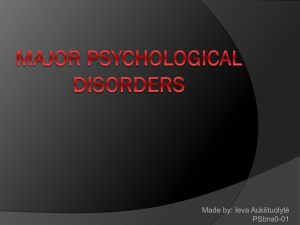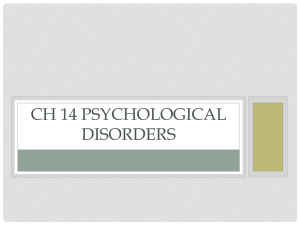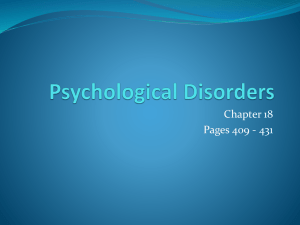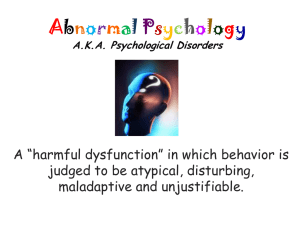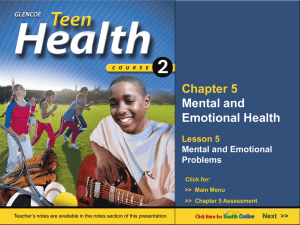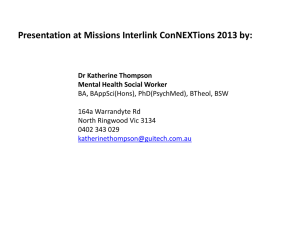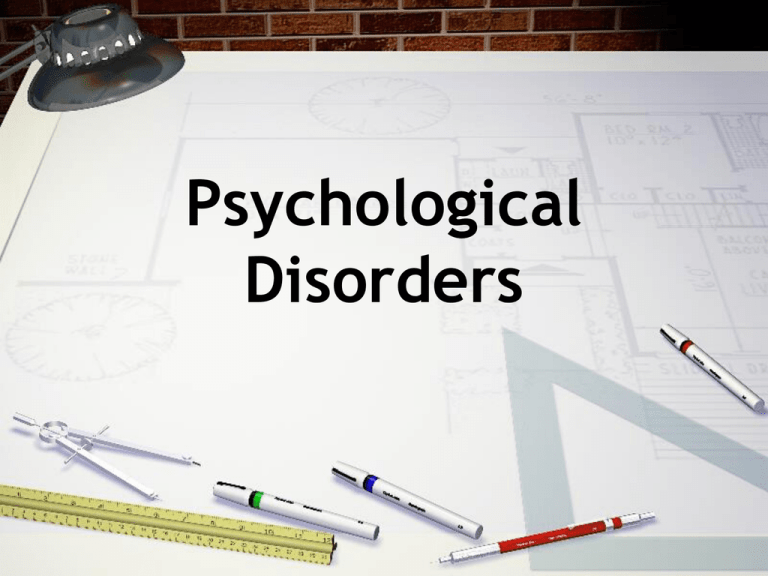
Psychological
Disorders
Defining Psychological
Disorders
a “harmful dysfunction” in which behavior is
judged to be:
maladaptive--harmful
unjustifiable--sometimes there’s a good
reason
Must include:
Personal discomfort (inner distress)
Change in life Functioning (success in meeting
expectations for performance in work or
school and social relationships)
Historical Views
• Supernatural view
– Mysterious actions indicated supernatural
powers
– Madness was a sign of possession
– Punishment: Burning at the stake
• Naturalistic View
– Hippocrates
– Madness was a sickness- treat with care
Theories of Nature,
Cause, and Treatment
• Biological Model
– Physiological malfunctions
• Psychoanalytic Model
– Result of unconscious internal conflict
• Cognitive-Behavioral
– Result of learning (learned inferiority)
• Diathesis-stress (integration)
– Biological predisposition combined with stressful
situation
• Systems approach (integration)
– Biological, psychological, and social combination
(biopsychosocial model)
Classification - DSM-IV
DSM-IV
American Psychiatric Association’s
Diagnostic and Statistical Manual of Mental
Disorders (Fourth Edition)
a widely used system for classifying
psychological disorders
presently distributed as DSM-IV-TR (text
revision)
Prevalence and Uses
• 15% experience mental disorder
– Top three: Anxiety, phobias, mood
•
•
•
•
6% substance abuse
Incidence: new cases in a given time
Prevalence: frequency of a case
“Insanity”- a legal term used in court
to avoid holding the ill accountable for
unjust actions
Mood Disorders
Definition: characterized by
emotional extremes
• Difference between sadness and clinical
depression?
– Normal = response to real-world situation,
lasts for a short period, typical reaction
Mood Disorders
Major Depressive Disorder
a mood disorder in which a person,
for no apparent reason, experiences
two or more weeks of depressed
moods, feelings of worthlessness,
and diminished interest or pleasure
in most activities
Mood Disorders
• MDD Symptoms
– Depressed mood
• Feeling sad or empty for most of the day, nearly every
day
– Loss of interest in pleasure
– Significant weight loss or gain
– Sleep disturbances
– Disturbances in motor activity
– Fatigue
– Worthlessness or self guilt
– Trouble concentration
– Recurrent thoughts of death
Mood Disorders
• Dysthymia
– Less intense sadness that persists for 2
years or more
Mood Disorders
• Bipolar Disorder
– Disorder in which an individual alternates
between feelings of MANIA (EUPHORIA) &
DEPRESSION
– Mania- active, talkative, high selfesteem, potentially aggressive
• Ben Stiller, Catherine Zeta-Jones, Brittney
Spears, DMX, Charlie Sheen
– Manic-Depressive Disorder (Kelsey and Chase)
Mood Disorders - Bipolar
• PET scans show that brain energy
consumption rises and falls with emotional
switches
Depressed state
Manic state
Depressed state
Causes of Mood
Disorders
• Biological Factors
– Identical Twin more likely to be depressed
than Fraternal
– Neurotransmitters
– Medications can treat (SSRIs)
• Psychological Factors
– Cognitive Distortions- “Twisting” a
situation and misinterpreting it severly
Depression & Women
Depression Rates
Depression & Suicide
Anxiety Disorders
Defined as: distressing, persistent anxiety
(don’t know cause or is inappropriate) or
maladaptive behaviors that reduce anxiety
Anxiety Disorders
Generalized Anxiety Disorder
Prolonged vague but intense fears- person
is tense, apprehensive, and in a state of
autonomic nervous system arousal (unable
to relax, constantly restless, rapid heart,
trouble sleeping)
“Free floating” anxiety
Anxiety Disorder
Panic Disorder
marked by a minutes-long episode of
intense dread in which a person
experiences terror and
accompanying chest pain, choking,
or other frightening sensation
No reasonable cause
Dread of having another panic attack
is stressful (agoraphobia?)
Anxiety Disorders
Specific Phobia
persistent, irrational fear of a specific object or
situation
–
–
–
–
–
–
–
–
–
–
Acerophobia - Fear of itching
Acrophobia - Fear of heights
Aerophobia - Fear of flying
Agoraphobia- Fear of open spaces (or being separated from sources of
security)
Atelophobia - Fear of imperfection
Autophobia - Fear of being alone
Lygophobia - Fear of darkness
Arachniphobia – Fear of spiders
Arachibutyrophobia – Fear of peanut butter sticking to the roof of your
mouth
Social Phobia- Fear of public situations (public speaking)
Anxiety Disorders
Obsessive-Compulsive Disorder
unwanted repetitive thoughts
(obsessions) and/or actions
(compulsions)
May experience anxiety if behavior is
stopped
Hoarding
Anxiety Disorders
• Post Traumatic Stress Disorder
(PTSD)
– Disorder in which victims of traumatic
events experience the original event in
the forms of dreams or flashbacks long
after the event
– Acute stress- immediately after
– A Soldier's Struggle with PTSD
Psychosomatic and
Somatoform Disorders
• Psychosomatic- “mind” and “body”
– Real illnesses that have a psychological
cause
– Ex: Tension headaches, High Blood
Pressure exacerbated by stress
– Joe Paterno?
• Somatoform- Believe they are
physically ill
– Problem is somatic (physical) in
appearance with no evidence of illness
Somatoform
Somatization disorder- Vague, recurring physical
symptoms with no cause (back pain, dizziness,
stomach pains, etc.)
Conversion Disorder -Conversion of emotional
difficulties into the loss of a specific physiological
function
If stuck with a pin, a limb will have no feeling
glove anesthesia- lack of feeling from the hand down
“Hysterical Blindness”
Hypocondriasis - A person who is in good health
becomes preoccupied with imaginary ailments (a
cough becomes a serious disease
BDD- Body Dysmorphic Disorder- imagined ugliness
Dissociative Disorders
• Dissociative Disorder - a disorder in
which a person experiences
alterations in memory, identity, or
consciousness
• Part of the person is dissociated from
the rest (memory, identity, etc.)
• i.e. Dissociative Amnesia- memory of war
victims is incomplete (selectively
forgotten)
Dissociative Fugue
A person suddenly and unexpectedly
travels away from home or work
and is unable to recall the pastrare
This person will assume an entirely
new identity
DID- Dissociative Identity
Disorder
• Formerly Multiple Personality
• A person exhibits two or more
personality states, each with
its own patterns of thinking
and behaving
• A.k.a. Multiple Personality
• http://www.youtube.com/watch?v=s5
a2PxSgZ28
Case Study
• “In general demeanor, Maud was quite different
from Sara. She walked with a swinging, bouncing
gait contrasted to Sara’s sedate one. While Sara
was depressed, Maud was ebullient and happy…
Insofar as she could Maud dressed different from
Sara… Sara used no make-up. Maud used a lot of
rough and lipstick…”
• Sara was mature (19.2 mental age, IQ 128), while
Maud was childish (6.6, IQ of 43)
Depersonalization
• Person suddenly feels changed or
different in a strange way
• Is common during adolescence, but
when this becomes long-term or
chronic it is classified as a dissociative
disorder
Sexual Disorders
• Sexual Dysfunction- loss or impairment of
physical responses
• Sexual Desire Disorder- lack of interest
• Paraphilias- Unconventional sex objects or
situations to obtain sex arousal (fantasies)
– Fetishism- repeated use of nonhuman
object to achieve arousal
– Exhibitionism, Pedophilia, Frotteurism,
Sexual Sadism, Masochism, Transvestic
Fetishism
Gender Identity
Disorders
• Desire to become a member of the
other biological sex
• Many times this is resolved by
adulthood
• If not, sexual reassignment surgery is
an option
• Cause: Biological?
• Two sexes is not enough to encompass
human sexuality?
Schizophrenia
Schizophrenia
literal translation “split mind”
a group of severe disorders
characterized by:
disorganized and delusional
thinking
disturbed perceptions
inappropriate emotions and
actions
Schizophrenia
Psychosis: A loss of touch from
reality
Delusions
false beliefs, often of persecution or
grandeur, that may accompany psychotic
disorders
Hallucinations
sensory experiences without sensory
stimulation
Subtypes of
Schizophrenia
Being chased by Russian spies, evil clowns, etc.- “Normal”
Giggling, Grimacing, Active but aimless
- Then overactive
Genetics &
Schizophrenia
Fluid-filled Brain Schizophrenia
Dopamine & DiathesisStress Hypothesis
• Dopamine Hypothesis -An excess of
dopamine at selected synapses is
related to a diagnosis of schizophrenia
• Diathesis-Stress Hypothesis Individual may have inherited a
predisposition toward schizophrenia
Personality Disorder
Personality Disorders
disorders characterized by inflexible
and enduring behavior patterns that
impair social functioning
usually without anxiety, depression,
or delusions
Types of Personality
Disorder
•
•
•
•
•
Antisocial- lie, cheat, steal, kill with no regret
Dependent- Unable to make decisions on their own
Histrionic - Excessive emotions; Seeks attention
Paranoid – Suspicious and mistrustful, hypersensitive to threats
Schizotypal, or Schizoid - Intense discomfort in close
relationships, lack desire to form social relationships
• Borderline- Instability in self-image, mood, and interpersonal
relationships; impulsive
• Narcissistic –grandiose sense of self-importance and
preoccupation with fantasies of success
• Avoidant- timid, anxious, and fearful of rejection, but wants
close relationships
Personality Disorder
Antisocial Personality Disorder
disorder in which the person (usually
man) exhibits a lack of conscience
for wrongdoing, even toward friends
and family members
may be aggressive and ruthless or a
clever con artist
Childhood Disorders
• ADHD (Attention-Deficit/hyperactivity
disorder)- lack ability to focus in a
sustained way
• Biological factors in central nervous
system
• Treatment- psychostimulants to “slow
down” hyperactive children
Autistic Disorder
• 1/500 Children
• 4x in boys
• Fail to form normal attachments,
distant and withdrawn, delayed speech
or develop echolalia (repetition of
words said to them)
• Strange motor behavior
• Precise cause unknown
• “Autism: The Musical”


